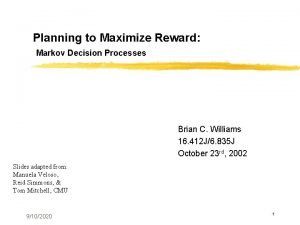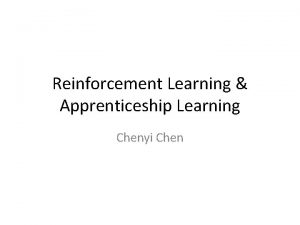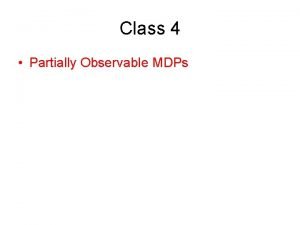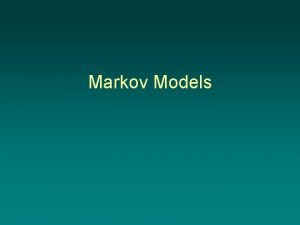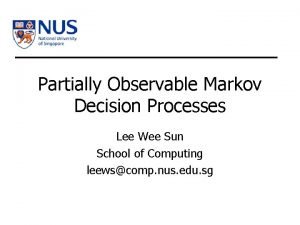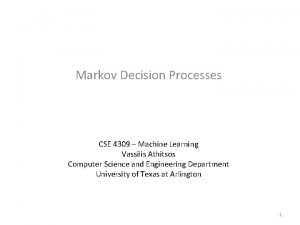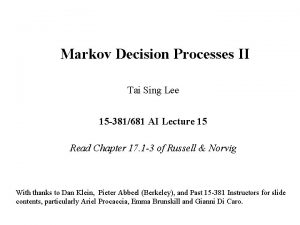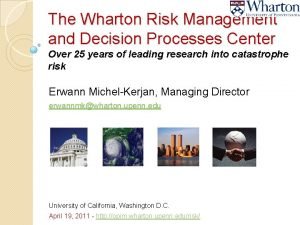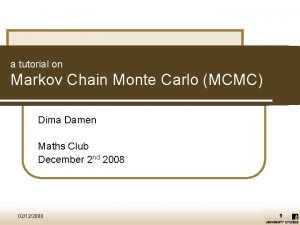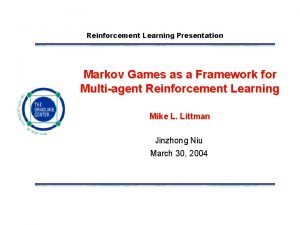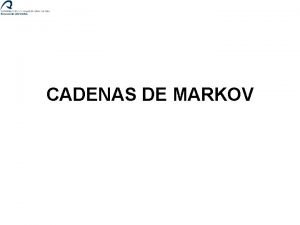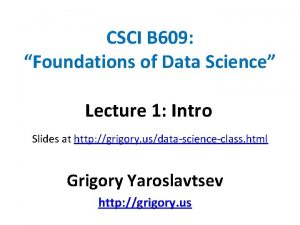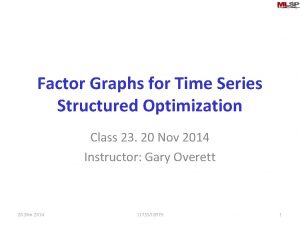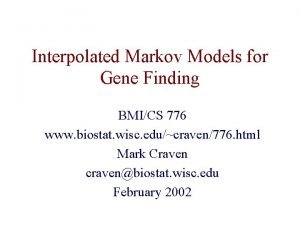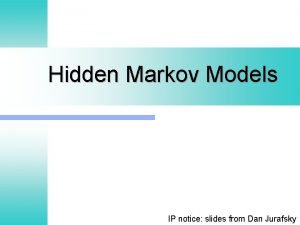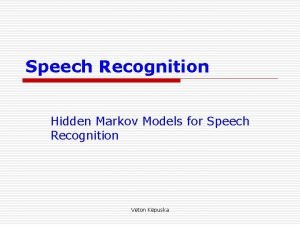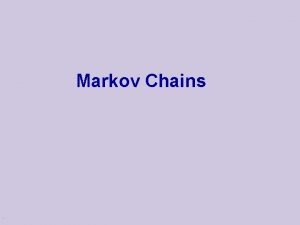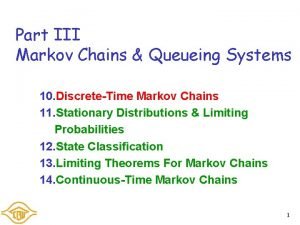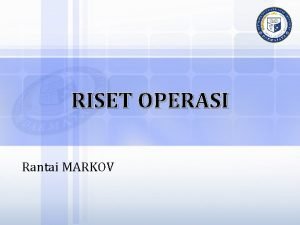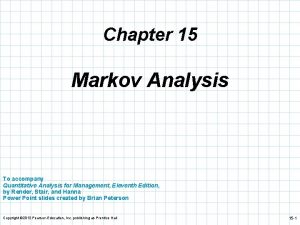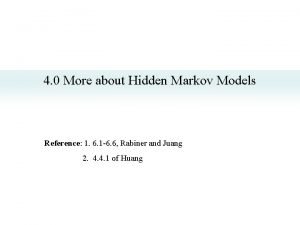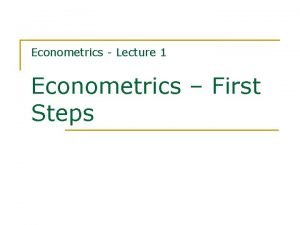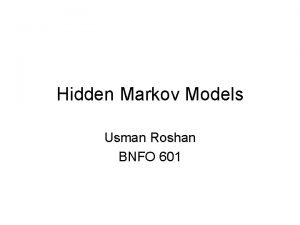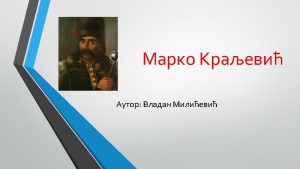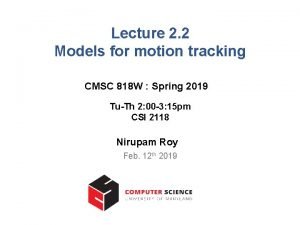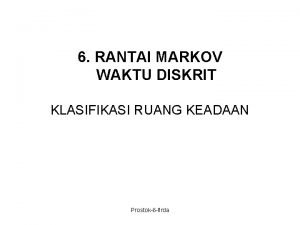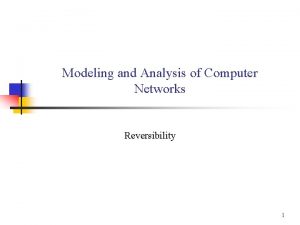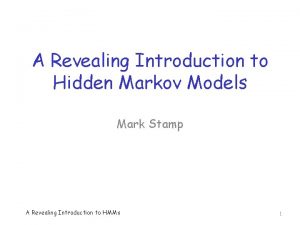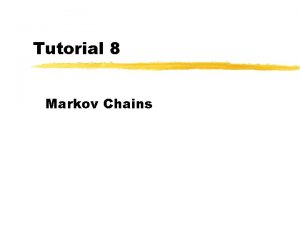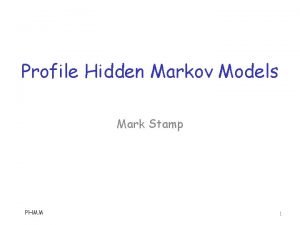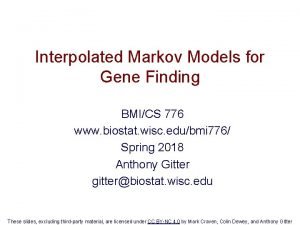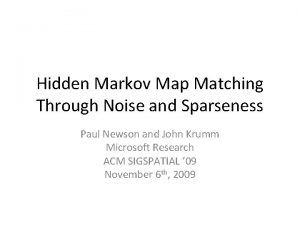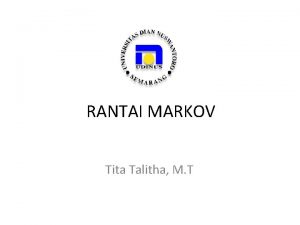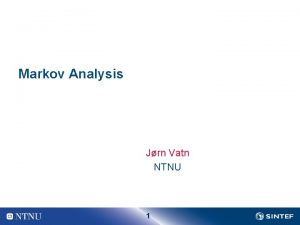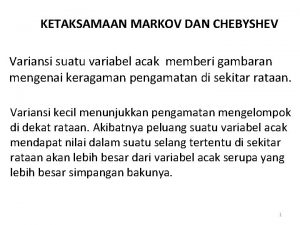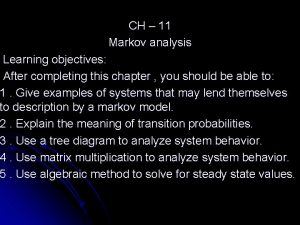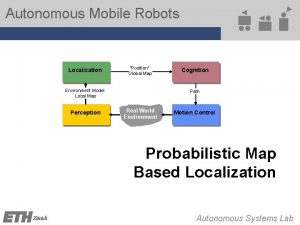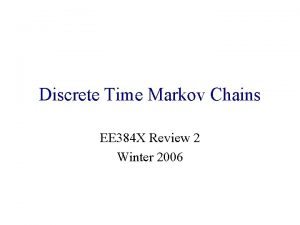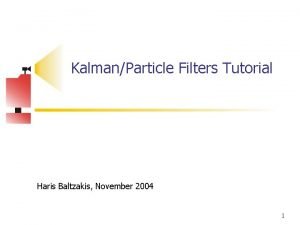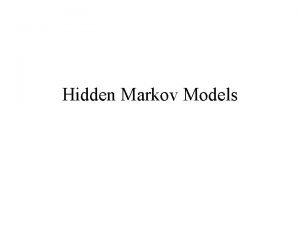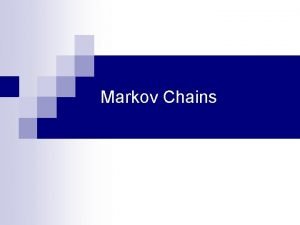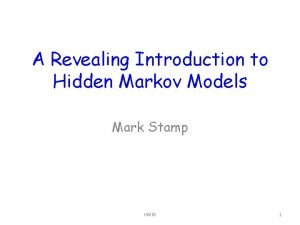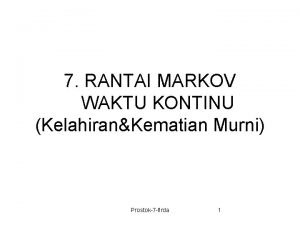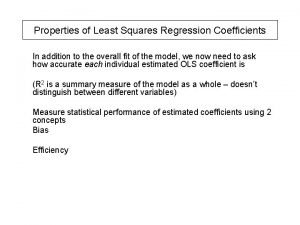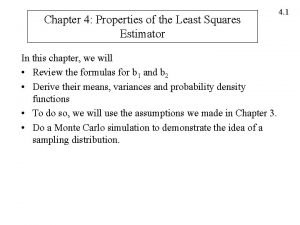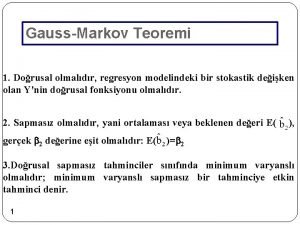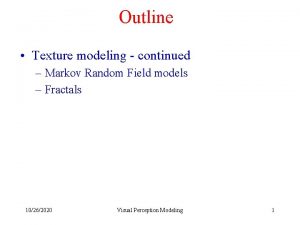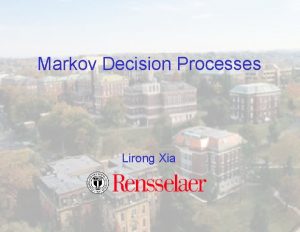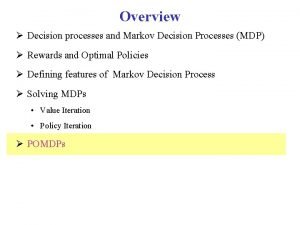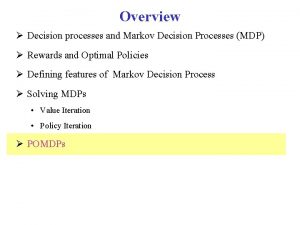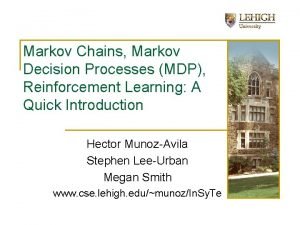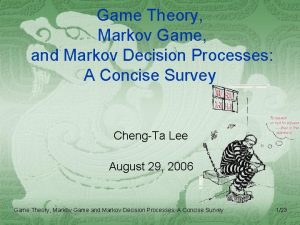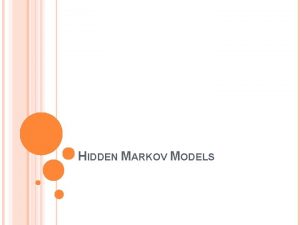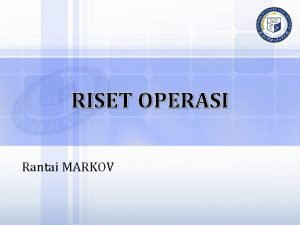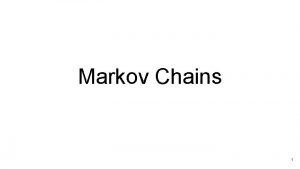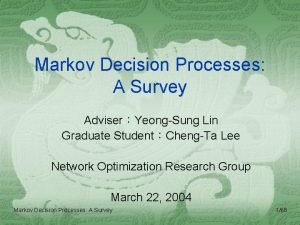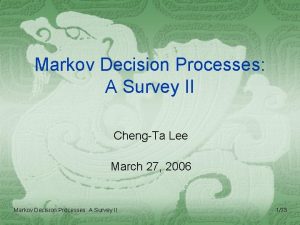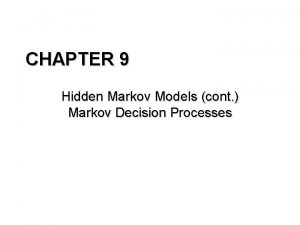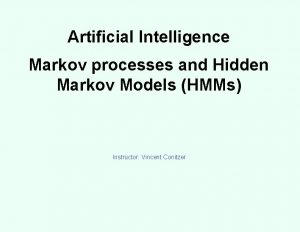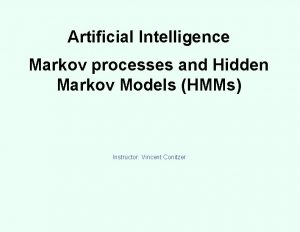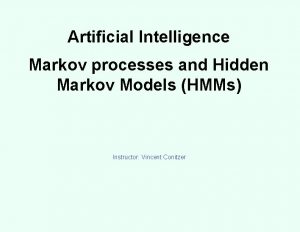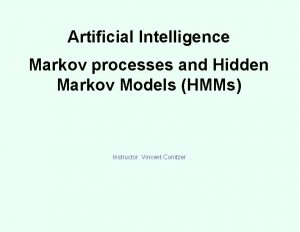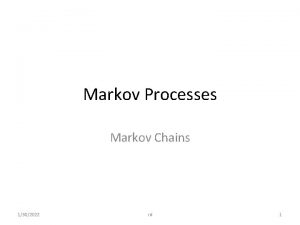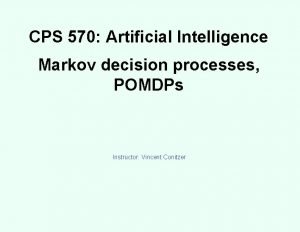Markov Decision Processes A Survey Martin L Puterman































































- Slides: 63

Markov Decision Processes: A Survey Martin L. Puterman

Outline • • Example - Airline Meal Planning MDP Overview and Applications Airline Meal Planning Models and Results MDP Theory and Computation Bayesian MDPs and Censored Models Reinforcement Learning Concluding Remarks Martin L. Puterman - June 2002 2

Airline Meal Planning • Goal: Get the right number of meals on each flight • Why is this hard? – Meal preparation lead times – Load uncertainty – Last minute uploading capacity constraints • Why is this important to an airline? – 500 flights per day 365 days $5/meal = $912, 500 Martin L. Puterman - June 2002 3

Martin L. Puterman - June 2002 4

Frequency How Significant is the Problem? -20 -10 0 10 20 30 Provisioning Error (Meals) Martin L. Puterman - June 2002 5

The Meal Planning Decision Process • At several key decision points up to 3 hours before departure, the meal planner observes reservations and meals allocated and adjusts allocated meal quantity. • Hourly in the last three hours, adjustments are made but the cost of adjustment is significantly higher and limited by delivery van capacity and uploading logistics. Martin L. Puterman - June 2002 6

Meal Planning Timeline 18 hours Schedule, Production 6 hours Order Assembly 3 hours Order ready to go Delivery of Order Departure Observe Passenger Load Adjustments with Van Martin L. Puterman - June 2002 7

Airline Meal Planning Operational goal; develop a meal planning strategy that minimizes expected total overage, underage and operational costs A Meal Planning Strategy specifies at each decision point the number of extra meals to prepare or deliver for any observed meal allocation and reservation quantity. Martin L. Puterman - June 2002 8

Why is Finding an Optimal Meal Planning Strategy Challenging? • • 6 decision points 108 passengers 108 possible actions One strategy requires 108 6 = 69984 order quantities. • There are 7, 558, 272 strategies to consider. • Demand must be forecasted. Martin L. Puterman - June 2002 9

Airline Meal Planning Characteristics • A similar decision is made at several time points • There are costs associated with each decision • The decision has future consequences • The overall cost depends on several events • There is uncertainty about the future Martin L. Puterman - June 2002 10

What is a Markov decision process? • A mathematical representation of a sequential decision making problem in which: – A system evolves through time. – A decision maker controls it by taking actions at pre-specified points of time. – Actions incur immediate costs or accrue immediate rewards and affect the subsequent system state. Martin L. Puterman - June 2002 11

MDP Overview Martin L. Puterman - June 2002 12

Markov Decision Processes are also known as: • • • MDPs Dynamic Programs Stochastic Dynamic Programs Sequential Decision Processes Stochastic Control Problems Martin L. Puterman - June 2002 13

Early Historical Perspective • • Massé - Reservoir Control (1940’s ) Wald - Sequential Analysis (1940’s ) Bellman - Dynamic Programing (1950’s) Arrow, Dvorestsky, Wolfowitz, Kiefer, Karlin - Inventory (1950’s) Howard (1960) - Finite State and Action Models Blackwell (1962) - Theoretical Foundation Derman, Ross, Denardo, Veinott (1960’s) - Theory - USA Dynkin, Krylov, Shirayev, Yushkevitch (1960’s) - Theory USSR Martin L. Puterman - June 2002 14

Basic Model Ingredients • Decision epochs – {0, 1, 2, …. , N} or [0, N] or {0, 1, 2, …} or [0, ) • State Space – S (generic state s) • Action Sets – As (generic action a) • Rewards – rt(s, a) • Transition probabilities – pt(j|s, a) A model is called stationary if rewards and transition probabilities are independent of t Martin L. Puterman - June 2002 15

System Evolution at at+1 st st+1 rt(st, at) Decision Epoch t rt+1(st+1, at+1) Decision Epoch t +1 Martin L. Puterman - June 2002 16

Another Perspective s 1 s 2 a 1 s 2 s 3 a 2 s 4 Martin L. Puterman - June 2002 17

Yet Another Perspective: An Event Timeline May 15 Place June order June 1 May order arrives; ship product to DCs June 10 May sales data arrives; prepare July forecast June 15 Place July order Martin L. Puterman - June 2002 . . . 18

Some Variants on the Basic Model • There may be a continuum of states and/or actions • Decisions may be made in continuous time • Rewards and transition rates may change over time • System state may be not observable • Some model parameters may not be known Martin L. Puterman - June 2002 19

Derived Quantities • Decision Rules: dt(s) • Policies, Strategies or Plans: = ( d 1, d 2, …) or = ( d 1, d 2, …, d. N) • Stochastic Processes : ( Xt, Yt ), Es { } • Value Functions: vt (s), v (s), g , … – Value functions differ from immediate rewards, they represent the value starting in a state of all future events Martin L. Puterman - June 2002 20

Objective Identify a policy that maximizes either the – expected total reward (finite or infinite horizon) v(s) = Es { rt (Xt, Yt ) } t=0 – expected discounted reward – expected long run average reward – expected utility possibly subject to constraints on system performance Martin L. Puterman - June 2002 21

The Bellman Equation MDP computation and theory focuses on solving the optimality (Bellman) equation which for infinite horizon discounted models This can also be expressed as v = Tv or Bv = 0 v(s) is the value function of the MDP Martin L. Puterman - June 2002 22

Some Theoretical Issues • When does an optimal policy with nice structure exist? – Markov or Stationary Policy – (s, S) or Control Limit Policy • When do computational algorithms converge? and how fast? • What properties do solutions of the optimality equation have? Martin L. Puterman - June 2002 23

Computing Optimal Policies • Why? – Implementation – Gold Standard for Heuristics • Basic Principle - Transform multi-period problem into a sequence of one-period problems. • Why is computation difficult in practice? – Curse of Dimensionality Martin L. Puterman - June 2002 24

Computational Methods • Finite Horizon Models – Backward Induction (Dynamic Programming) • Infinite Horizon Models – – – Value Iteration Policy Iteration Modified Policy Iteration Linear Programming Neuro-Dynamic Programming/Reinforcement learning Martin L. Puterman - June 2002 25

Infinite Horizon Computation • Iterative algorithms work as follows: ~ – Approximate the value function by v(s) – Select a new decision rule by – Re-approximate the value function • Approximation methods – exact - policy iteration – iterative - value iteration and modified policy iteration – simulation based - reinforcement learning Martin L. Puterman - June 2002 26

Applications (A to N) • • • Airline Meal Planning Behaviourial Ecology Capacity Expansion Decision Analysis Equipment Replacement • Fisheries Management • Gambling Systems • Highway Pavement Repair • Inventory Control • Job Seeking Strategies • Knapsack Problems • Learning • Medical Treatment • Network Control Martin L. Puterman - June 2002 27

Applications (O to Z) • Option Pricing • Project Selection • Queueing System Control • Robotic Motion • Scheduling • Tetris • • • User Modeling Vision (Computer) Water Resources X-Ray Dosage Yield Management Zebra Hunting Martin L. Puterman - June 2002 28

“Coffee, Tea or …? A Markov Decision Process Model for Airline Meal Provisioning” J. Goto, M. E. Lewis and MLP • Decision Epochs: T= {1, …, 5} – – 0 - Departure time 1 -3: 1, 2 and 3 Hours Pre-Departure 4: 6 Hours Pre - Departure 5: 36 Hours Pre-Departure • States: {(l, q): 0 l Booking Limit, 0 q Capacity} • Actions: (Meal quantity after delivery) – At, (l, q)= { 0, 1, …, Plane Capacity} t = 3, 4, 5 – At, (l, q) = {q-van capacity, …, q + van capacity) Martin L. Puterman - June 2002 t= 1, 2 29

Markov Decision Process Formulation Costs: (depending on t) rt((l, q), a) = Meal Cost + Return penalty + late delivery charge + shortage cost Transition Probabilities: pt(q’|q) pt((l’, q’)|(l, q), a) = 0 a=q’ a q’ Martin L. Puterman - June 2002 30

An Optimal Decision Rule 18 hours Schedule, Production Passenger Load Decision Epoch 1 Meal Quantity 6 hours Order Assembly 3 hours Order ready to go Martin L. Puterman - June 2002 Adjust Departure with Van 31

Empirical Performance Frequency Actual Mean = 9. 81 Standard Deviation = 8. 46 Frequency Model (out of sample) Mean = 7. 99 Standard Deviation = 6. 96 -20 0 20 40 Provisioning Error Martin L. Puterman - June 2002 32

Overage versus Shortage • Evaluate the model over a range of terminal costs • Observe the relationship of average overage and proportion of flights short-catered • 55 flight number / aircraft capacity combinations (evaluated separately) Martin L. Puterman - June 2002 33

Overage versus Shortage Performance of optimal policies Martin L. Puterman - June 2002 34

Information Acquisition Martin L. Puterman - June 2002 35

Information Acquisition and Optimization • Objective: Investigate the tradeoff between acquiring information and optimal policy choice • Examples: – Harpaz, Lee and Winkler (1982) study output decisions of a competitive firm in a market with random demand in which the demand distribution is unknown. – Braden and Oren (1994) study dynamic pricing decisions of a firm in a market with unknown consumer demand curves. – Lariviere and Porteus (1999) and Ding, Puterman and Bisi (2002) study order decisions of a censored newsvendor with unobservable lost sales and unknown demand distributions. • Key result - it is optimal to “experiment” Martin L. Puterman - June 2002 36

Bayesian Newsvendor Model • Newsvendor cost structure (c - cost, h - salvage value, p - penalty cost) • Demand assumptions – positive continuous – i. i. d. sample from f(x| ) with unknown – prior on is 1( ) • Assume first that demand is unobservable Demand = Sales + “observed” lost sales Martin L. Puterman - June 2002 37

Time Line of Events set y 1 1 obs. x 1 set obs. y 2 x 2 2 Martin L. Puterman - June 2002 3 38

Demand Updating xn n n+1 Martin L. Puterman - June 2002 39

Bayesian Newsvendor Model Bayesian MDP Formulation At decision epoch n, (n=1, 2, . . . , N) – States: {all probability distributions on the unknown parameter} – Actions: – Costs: – Transition Prob: Martin L. Puterman - June 2002 40

Bayesian Newsvendor Model The Optimality Equations for n=1, …, N with the boundary condition: Key Observation The transition probabilities are independent of the actions. So the problem can be reduced to a sequence of single-period problems. Martin L. Puterman - June 2002 41

The Bayesian Newsvendor Policy The BMDP reduces to a sequence of single-period, two-step problems. • Demand distribution parameter updating xn-1 • Cost minimization where Mn is the CDF of mn Martin L. Puterman - June 2002 42

Bayesian Newsvendor with Unobservable Lost Sales • Model Set-up – Same as fully observable case but unmet demand is lost and unobservable • Question – Is the Bayesian Newsvendor policy optimal? Martin L. Puterman - June 2002 43

Bayesian Newsvendor with Unobservable Lost Sales Demand is censored by the order quantity. : demand exactly observed : demand censored Demand updating is different in this case: Martin L. Puterman - June 2002 44

Bayesian Newsvendor with Unobservable Lost Sales Set yn-1 0) ( -1 0 = -1 mn h t wi xn ) 1. ( s m 1 b n ith o w 1 = obs. x n-1 obs . x n-1 =y n-1 wit h [1 -M n-1 (y n -1 ) ] Martin L. Puterman - June 2002 45

Bayesian Newsvendor with Unobservable Lost Sales Model Formulation – States, Actions, Costs: As above – Transition Probabilities: The Optimality Equations Martin L. Puterman - June 2002 46

Bayesian Newsvendor with Unobservable Lost Sales The Key Result if f(x| ) is likelihood order increasing in . • In this model, decisions in separate periods are interrelated through the optimality equation. • This means that it is optimal to tradeoff learning for short term optimality. • Question: What is an upper bound on yn*? Martin L. Puterman - June 2002 47

Bayesian Newsvendor with Unobservable Lost Sales Solving the optimality equations gives For N: For n=1, . . . , N-1, where p’(yn) is a “policy dependent penalty cost. Proof of key result is based on showing p’(yn) > p for n < N. Martin L. Puterman - June 2002 48

Bayesian Newsvendor with Unobservable Lost Sales • Some comments – The extra penalty can be interpreted as the marginal expected value of information at decision epoch n. – Numerical results show small improvements when using the optimal policy as opposed to the Bayesian Newsvendor policy. – We have extended this to a two level supply chain Martin L. Puterman - June 2002 49

Partially Observed MDPs • In POMDPs, system state is not observable. – Decision maker receives a signal y which is related to the system state by q(y|s, a). • Analysis is based on using Bayes Theorem to estimate distribution of the system state given the signal – Similar to Bayesian MDPs described above • the posterior state distribution is a sufficient statistic for decision making – State space is a continuum – Early work by Smallwood and Sondik (1972) • Applications – Medical diagnosis and treatment – Equipment repair Martin L. Puterman - June 2002 50

Reinforcement Learning and Neuro-Dynamic Programming Martin L. Puterman - June 2002 51

Neuro-Dynamic Programming or Reinforcement Learning • A different way to think about dynamic programming – Basis in artificial intelligence research – Mimics learning behavior of animals • Developed to: – Solve problems with high dimensional state spaces and/or – Solve problems in which the system is described by a simulator (as opposed to a mathematical model) • NDL/Rl refers to a collection of methods combining Monte Carlo methods with MDP concepts Martin L. Puterman - June 2002 52

Reinforcement Learning • Mimics learning by experimenting in real life – learn by interacting with the environment – goal is long term – uncertainty may be present (task must be repeated many time to obtain its value) • Trades off between exploration and exploitation • Key focus is estimating value function ( v(s) or Q(s, a) ) – Start with guess of value function – Carry out task and observe immediate outcome (reward and transition) – Update value function Martin L. Puterman - June 2002 53

Reinforcement Learning - Example • Playing Tic-Tac-Toe (Sutton and Barto, 2000) – You know the rules of the game but not opponents strategy (assumed fixed over time but with random component) – Approach • List possible system states • Start with initial guess of probability of winning in each state • Observe current state (s) and choose action that will move you to state with highest probability of winning • Observe state (s’) after opponent plays • Revise value in state s based on value in s’. – Player might not always choose “best action” but try other actions to learn about different states. Martin L. Puterman - June 2002 54

Reinforcement Learning - Example • Observations about Tic-Tac-Toe Example – Dimension of state space is 39 – Writing down a mathematical model for the game is challenging, simulating it is easy. – Goal is to maximize the probability of winning, there is no immediate reward – Possible updating mechanism using observations vnew(s) = vold(s) + ( vold(s’) - vold(s) ) • is a step-size parameter • vold(s’) - vold(s) is a temporal-difference – The subsequent state s’ depends on players action. Martin L. Puterman - June 2002 55

Reinforcement Learning Problems can be classified in two ways Martin L. Puterman - June 2002 56

Temporal Difference Updating • No model example, discounted case - based on Q(s, a) • Algorithm (policy specified) – Start system in s, choose action a and observe s’ and a’ – Update Q(s, a) + ( r + Q(s’, a’) - Q(s, a)) – Repeat replacing (s, a) by (s’, a’) • Algorithm (no-policy specified) (Q-Learning) – Start system in s, choose action a and observe s’ and a’ – Update Q(s, a) + ( r + max a’ A Q(s’, a’) - Q(s, a)) – Repeat replacing s by s’ • Issues include choosing and stopping criteria Martin L. Puterman - June 2002 57

RL Function Approximation • High-dimensionality addressed by – replacing v(s) or Q(s, a) by representation and then applying Q-learning algorithm updating weights wi at each iteration, or – approximating v(s) or Q(s, a) by a neural network • Issue: choose “basis functions” i(s, a) to reflect problem structure Martin L. Puterman - June 2002 58

RL Applications • • Backgammon Checker Player Robot Control Elevator Dispatching Dynamic Telecommunications Channel Allocation Job Shop Scheduling Supply Chain Management Martin L. Puterman - June 2002 59

Neuro-Dynamic Programming Reinforcement Learning “It is unclear which algorithms and parameter settings will work on a particular problem, and when a method does work, it is still unclear which ingredients are actually necessary for success. As a result, applications often require trial and error in a long process of a parameter tweaking and experimentation. ” van Roy - 2002 Martin L. Puterman - June 2002 60

Conclusions Martin L. Puterman - June 2002 61

Concluding Comments • MDPs provide an elegant formal framework for sequential decision making • They are widely applicable – They can be used to compute optimal policies – They can be used as a baseline to evaluate heuristics – They can be used to determine structural results about optimal policies • Recent research is addressing “The Curse of Dimensionality” Martin L. Puterman - June 2002 62

Some References Bertsekas, D. P. and Tsitsiklis, J. N. , Neuro-Dynamic Programming, Athena, 1996. Feinberg, E. A. and Shwartz, A. Handbook of Markov Decision Processes: Methods and Applications, Kluwer 2002. Puterman, M. L. Markov Decision Processes, Wiley, 1994. Sutton, R. S. and Barto, A. G. Reinforcement Learning, MIT, 2000. Martin L. Puterman - June 2002 63
 Martin l. puterman
Martin l. puterman Investment decision financing decision dividend decision
Investment decision financing decision dividend decision Objectives of decision making
Objectives of decision making Markov decision
Markov decision Value iteration
Value iteration Markov decision
Markov decision Markov decision
Markov decision Markov decision process merupakan tuple dari
Markov decision process merupakan tuple dari Markov decision process
Markov decision process Markov decision
Markov decision Tai sing lee
Tai sing lee Concurrent in os
Concurrent in os Opim wharton
Opim wharton 叫叫abcd
叫叫abcd Decision tree and decision table examples
Decision tree and decision table examples Mcmc tutorial
Mcmc tutorial Hidden markov model rock paper scissors
Hidden markov model rock paper scissors _
_ Markov inequality proof
Markov inequality proof Markov factorization
Markov factorization Bmics
Bmics Hidden markov chain
Hidden markov chain Markov process adalah
Markov process adalah Aperiodic markov chain
Aperiodic markov chain Hidden markov model
Hidden markov model Aperiodic markov chain
Aperiodic markov chain Markov chain operations research
Markov chain operations research Integrated knowledge sets within an organization
Integrated knowledge sets within an organization What is markov analysis
What is markov analysis Markov
Markov Gauss markov assumptions
Gauss markov assumptions Hidden markov models
Hidden markov models Djevojka nadmudrila marka
Djevojka nadmudrila marka Tracking cmsc
Tracking cmsc Rantai markov waktu diskrit
Rantai markov waktu diskrit Embedded markov chain
Embedded markov chain Markov model
Markov model A revealing introduction to hidden markov models
A revealing introduction to hidden markov models Gauss markov assumptions
Gauss markov assumptions Markov chains tutorial
Markov chains tutorial định lý gauss markov
định lý gauss markov Markov
Markov Gene finding
Gene finding Hidden markov map matching through noise and sparseness
Hidden markov map matching through noise and sparseness Pijipin
Pijipin Jørn vatn
Jørn vatn Contoh kasus, analisis markov
Contoh kasus, analisis markov Markov chain natural language processing
Markov chain natural language processing Ketaksamaan markov
Ketaksamaan markov Kpuska
Kpuska Example of markov analysis
Example of markov analysis Markov localization
Markov localization Aperiodic markov chain
Aperiodic markov chain Sasha markov
Sasha markov Markov localization
Markov localization Markov
Markov Aperiodic markov chain
Aperiodic markov chain A revealing introduction to hidden markov models
A revealing introduction to hidden markov models Contoh soal rantai markov waktu kontinu
Contoh soal rantai markov waktu kontinu Gauss markov assumptions
Gauss markov assumptions Properties of least square estimator
Properties of least square estimator Markov chain absorbing state
Markov chain absorbing state Markov teoremi
Markov teoremi Markov
Markov




